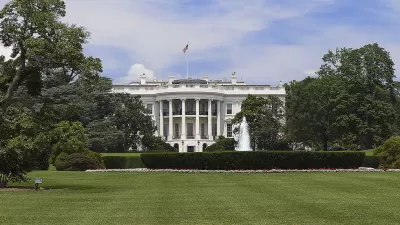Singapore's carefully designed public housing that supports mixed-incomes, green space, and access to high-quality transportation is a good benchmark for the Biden administration's new push to root out systemic racism in the housing market.

President Biden signed an executive order on January 26 directing the U.S. Department of Housing and Urban Development (HUD) to begin the process of rooting out systemic racism in the housing market. Turning to Singapore for lessons on how to provide high-quality, affordable public housing is an excellent place to start. Why? Because not only has Singapore managed to provide near-universal public housing—over 80% of Singaporeans live in government-built housing—but they get the fundamentals right: carefully designed housing projects that support mixed-incomes, beautiful green spaces, and access to high-quality public transportation.
Mention the term "public housing" in the United States and what comes to mind is decrepit, crowded, and poorly maintained ghettoes, often pushed to a cities' outskirts. But Singapore, which is internationally recognized as having one of the best public housing programs in the world, is as far from this dystopian vision as you can get.
Low-density zoning restrictions, excessive parking requirements, and high development fees are just a few reasons for the continued undersupply of affordable housing in the United States, according to a Harvard University’s "State of the Nation’s Housing 2020" report, sponsored by Habitat for Humanity. And the consequences are alarming, especially as they relate to racial segregation and access to affordable housing:
- Before the COVID-19 pandemic, 37.1 million households (30 percent) were cost-burdened in 2019, spending over 30 percent of their incomes on housing, including 17.6 million (14 percent) who were severely cost-burdened (spending over 50 percent of their income on housing).
- In 2019, homeownership rose to 64.6 percent, up from a recent low of 63.4 percent in 2016, but still down from the all-time high of 69 percent in 2004.
- While the homeownership rate for white households rose to 73.3 percent in 2019, Black households held flat at 42.8 percent, widening the gap between the rates to 30.6 percentage points, the largest since 1983, which reflects the legacy of decades of discriminatory policies and inequitable access to homeownership.
- Residential segregation remains a significant problem in the country. Nearly two-thirds of low-income Black, Hispanic, and Native American individuals live in high-poverty areas, compared to one-third of low-income white individuals.
Peter Dreier, distinguished professor of politics at Occidental College, got straight to the point in the spring 2018 issue of The American Prospect magazine. Providing affordable housing in America is hobbled by one fundamental reality: "Too much housing is in the market sector and too little is in a social sector permanently protected from rising prices."
With middle class wages mostly stagnant since the 1980s, and housing prices driven up by supply-demand imbalances, Dreier writes that "government is required to provide more and more subsidies to keep rents within the bounds of incomes." To no one’s surprise, Dreier continues, "housing vouchers have become, by far, the largest federal subsidy program."
In 2019, HUD provided over $22 billion in voucher funding to low-income families, who used them to secure housing in the private market. Families pay 30 percent of their income and HUD pays the rest. But HUD puts a ceiling on voucher payments, which leaves apartments in more affluent neighborhoods off-limits to voucher holders.
Though Dreier goes on to highlight some of the public housing successes in Austria—which are formidable and worthy of consideration—I spent some time in Singapore last year on assignment and was awed by Singapore’s approach to public housing.
Singapore is a multi-ethnic Chinese, Malay, and Indian city-state, and despite being one of the densest cities in the world, it consistently scores amongst the highest in city livability rankings. In 2017 it had a population of 5.61 million on 709 square kilometers (274 square miles) for a density of 7,796 per km². Chicago, by contrast, has a population of 2.7 million on 589 square kilometers (227 square miles) for a density of 4,613 per km², making it almost half as dense as Singapore.
When Singapore gained independence from the British in 1959, only 9% of Singaporeans resided in public housing. As of 2019, more than 80% of Singaporeans live in government-built apartments. There are about one million Housing and Development Board (HDB) apartments, largely clustered in 24 towns throughout the city. By comparison, public housing in the United States constitutes less than 1 percent of the nation's housing stock—around 1.1 million apartments that house about 2.1 million low-income people.
But unlike U.S. housing programs, which tend to concentrate the poor in low-income ghettos in city suburbs, the secret to Singapore's success is that their housing projects are carefully designed to support mixed-incomes, beautiful green spaces, and access to high-quality public transportation that conveniently links residents to education and community centers. And last but not least, couple all that with the famous Singapore hawker centers (food courts) where all income classes and ethnicities meet, socialize, and dine on Singapore's famously delicious and affordable cuisine.
As one of my local colleagues explained, HDB housing blocks are strategically designed to encourage the "kampong" spirit (social cohesion) by fostering interactions between neighbors, and the final product is an undeniable sense of community.
Making much of this possible is the government's ability to buy land for cheap, combined with a heavy emphasis on standardization and efficiencies in construction management.
The Land Acquisition Act of 1967 empowers the government to acquire land at low cost for public use, and today 90% of the land is owned by the state, as opposed to 49% in 1965. The "Core Contractor Scheme," introduced in 1982, was a merit-based system whereby the government guaranteed annual work for a fixed number of years on account of their good record. For every merit star earned, the contractor would enjoy a 0.5% bidding preference when tenders were evaluated. The program was replaced with the "Core Tender Scheme" in 1988, which has since evolved but has the same aim as the original program.
As governments all around the world struggle with providing their populations high-quality affordable housing, a key component of the United Nations’ Sustainable Development Goal (SDG) 11, perhaps no country has met the challenge better than Singapore.
And though skeptics may argue that Singapore is a small, rich country whose public housing program isn’t replicable beyond its shores, they are missing the point.
Singapore's success lies in a governing philosophy that gets the fundamentals right. Prioritize good design principles that are aesthetically pleasing. Incorporate green spaces and high-quality public transportation. Mix income levels and ethnic groups (that's right, pack them in nice and tight), and create social cohesion by fostering interaction and plenty of opportunities to eat and socialize together.
Get the fundamentals right—the adage goes—and the rest will follow. And that doesn't just apply to Singapore.

Planetizen Federal Action Tracker
A weekly monitor of how Trump’s orders and actions are impacting planners and planning in America.

Restaurant Patios Were a Pandemic Win — Why Were They so Hard to Keep?
Social distancing requirements and changes in travel patterns prompted cities to pilot new uses for street and sidewalk space. Then it got complicated.

Map: Where Senate Republicans Want to Sell Your Public Lands
For public land advocates, the Senate Republicans’ proposal to sell millions of acres of public land in the West is “the biggest fight of their careers.”

Maui's Vacation Rental Debate Turns Ugly
Verbal attacks, misinformation campaigns and fistfights plague a high-stakes debate to convert thousands of vacation rentals into long-term housing.

San Francisco Suspends Traffic Calming Amidst Record Deaths
Citing “a challenging fiscal landscape,” the city will cease the program on the heels of 42 traffic deaths, including 24 pedestrians.

California Homeless Arrests, Citations Spike After Ruling
An investigation reveals that anti-homeless actions increased up to 500% after Grants Pass v. Johnson — even in cities claiming no policy change.
Urban Design for Planners 1: Software Tools
This six-course series explores essential urban design concepts using open source software and equips planners with the tools they need to participate fully in the urban design process.
Planning for Universal Design
Learn the tools for implementing Universal Design in planning regulations.
Heyer Gruel & Associates PA
JM Goldson LLC
Custer County Colorado
City of Camden Redevelopment Agency
City of Astoria
Transportation Research & Education Center (TREC) at Portland State University
Camden Redevelopment Agency
City of Claremont
Municipality of Princeton (NJ)





























